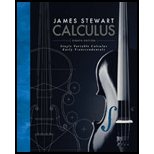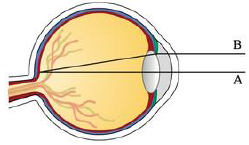
Concept explainers
Light enters the eye through the pupil and strikes the retina, where photoreceptor cells sense light and color. W. Stanley Stiles and B. H. Crawford studied the phenomenon in which measured brightness decreases as light enters farther from the center of the pupil. (See the figure.)

A light beam A that enters through the center of the pupil measures brighter than a beam B entering near the edge of the pupil.
They detailed their findings of this phenomenon, known as the Stiles–Crawford effect of the first kind, in an important paper published in 1933. In particular, they observed that the amount of luminance sensed was not proportional to the area of the pupil as they expected. The percentage P of the total luminance entering a pupil of radius r mm that is sensed at the retina can be described by
where ρ is an experimentally determined constant, typically about 0.05.
(a) What is the percentage of luminance sensed by a pupil of radius 3 mm? Use ρ = 0.05.
(b) Compute the percentage of luminance sensed by a pupil of radius 2 mm. Does it make sense that it is larger than the answer to part (a)?
(c) Compute
Source: Adapted from W. Stiles and B. Crawford, “The Luminous Efficiency of Rays Entering the Eye Pupil at Different Points.” Proceedings of the Royal Society of London, Series B: Biological Sciences 112 (1933): 428–50.
Want to see the full answer?
Check out a sample textbook solution
Chapter 4 Solutions
Single Variable Calculus: Early Transcendentals
- Find the distance from the point (-9, -3, 0) to the line ä(t) = (−4, 1, −1)t + (0, 1, −3) .arrow_forward1 Find a vector parallel to the line defined by the parametric equations (x(t) = -2t y(t) == 1- 9t z(t) = -1-t Additionally, find a point on the line.arrow_forwardFind the (perpendicular) distance from the line given by the parametric equations (x(t) = 5+9t y(t) = 7t = 2-9t z(t) to the point (-1, 1, −3).arrow_forward
- Let ä(t) = (3,-2,-5)t + (7,−1, 2) and (u) = (5,0, 3)u + (−3,−9,3). Find the acute angle (in degrees) between the lines:arrow_forwardA tank initially contains 50 gal of pure water. Brine containing 3 lb of salt per gallon enters the tank at 2 gal/min, and the (perfectly mixed) solution leaves the tank at 3 gal/min. Thus, the tank is empty after exactly 50 min. (a) Find the amount of salt in the tank after t minutes. (b) What is the maximum amount of salt ever in the tank?arrow_forwardpleasd dont use chat gptarrow_forward
- Draw the vertical and horizontal asymptotes. Then plot the intercepts (if any), and plot at least one point on each side of each vertical asymptote.arrow_forwardDraw the asymptotes (if there are any). Then plot two points on each piece of the graph.arrow_forwardCancel Done RESET Suppose that R(x) is a polynomial of degree 7 whose coefficients are real numbers. Also, suppose that R(x) has the following zeros. -1-4i, -3i, 5+i Answer the following. (a) Find another zero of R(x). ☐ | | | | |│ | | | -1 བ ¢ Live Adjust Filters Croparrow_forward
- Algebra & Trigonometry with Analytic GeometryAlgebraISBN:9781133382119Author:SwokowskiPublisher:Cengage
